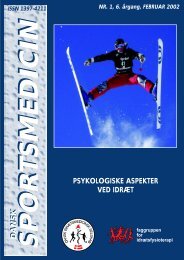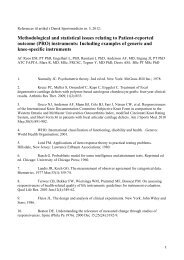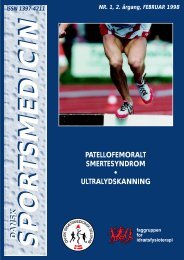Nr. 1/05 samlet - Dansk Sportsmedicin
Nr. 1/05 samlet - Dansk Sportsmedicin
Nr. 1/05 samlet - Dansk Sportsmedicin
You also want an ePaper? Increase the reach of your titles
YUMPU automatically turns print PDFs into web optimized ePapers that Google loves.
28<br />
Idrætsmedicinsk Årskongres<br />
stress (N/m 2 ). Stiffness (N/mm) was derived from force-displacement curves. The highest<br />
and lowest values of each day were discarded. Paired student’s t-test, Pearson<br />
correlation coefficient and typical error (%) for duplicate measures were used for statistics.<br />
Results: (mean±sem) Tibial displacement (1.34±0.25 mm) corresponded to 45 ±<br />
8% of total displacement (3.18±0.39 mm). Within-day there was no difference between<br />
trials for stiffness (trial a, 4334(562N/mm; trial b, 4273(533 N/mm) and strain (trial a,<br />
6.9±0.6%; trial b, 6.8±0.7%). Correlation coefficients and typical errors were 0.95 and<br />
9.9% for stiffness, 0.97 and 5.5% for strain. Between days there was no difference between<br />
trials for stiffness (day 1, 3725(293 N/mm; day 2, 4195(369 N/mm) and strain<br />
(day 1, 7.0±0.4%, day 2, 6.8±0.4%). Conclusion: Ultrasonography provides accurate<br />
and reproducible measurements of patella tendon elongation, in vivo, within and between<br />
days. The technique can therefore be used to investigate changes in patellar tendon<br />
biomechanics as a function of intervention. However, tibial movement represents<br />
45% of elongation and must be accounted for.<br />
11. WHAT IS A NORMAL ACHILLES TENDON ON ULTRASOUND? DOPPLER<br />
BEFORE AND AFTER CONTRAST AGENT<br />
Koening, M.J1 ; Torp-Pedersen, S1 ; Hölmich, P2 ; Bachmann, M3 ; and Bliddal, H1 1 2 3 Parker Instituttet, Frederiksberg Hospital; Ortopædkirurgisk afdeling, Amager Hospital; Radiologisk<br />
afdeling X, ultralydssektionen, Rigshospitalet<br />
Introduction: Achilles tendonitis is typically seen on ultrasound (US) as a thickened<br />
spindle-shaped tendon with disruption of the internal architecture and Doppler activity.<br />
The latter seems closely linked to disease activity and decreases or disappears when<br />
symptoms disappear. With spectral Doppler, the type of flow is expressed with resistive<br />
index (RI). Low RI values are associated with inflammation and a value of 1.00 is<br />
normal. When the vessels disappear, it is not possible to measure the RI and it is assumed<br />
that the resistance has normalised. This study was performed to test if normal<br />
tendinous vessels visualized with contrast indeed had normal RI. Material: Twentythree<br />
asymptomatic tendons were scanned before 5 ultrasonically normal tendons in 5<br />
subjects were identified. Methods US was performed with a 14 MHz linear transducer.<br />
A normal tendon was defined as a clearly demarcated tendon with homogeneous fibrillar<br />
architecture, without spindle shape and without Doppler activity. In the five<br />
normal tendons contrast was used to bring vessels to visualization. Results: In the 5<br />
ultrasonically normal tendons, arteries could be detected with Doppler after contrast,<br />
in all cases with normal RI values. All the vessels were located in the midportion of the<br />
tendon. Eighteen tendons had US abnormalities on grey-scale examination and all these<br />
cases all had Doppler activity in the abnormal area. Conclusion: The majority of<br />
normal, healthy subjects had abnormalities in the Achilles tendon on grey-scale US<br />
and in all these a detectable intratendinous perfusion was present when examined<br />
with Doppler. After injection of US contrast agent all 5 normal Achilles tendons developed<br />
a detectable flow, which was normal in profile – RI = 1.00. Our US criteria<br />
seem too extensive since a majority of asymptomatic and clinically normal subjects<br />
have abnormal tendons on US. We believe there is a need for an age-stratified normal<br />
material.<br />
12. IMMEDIATE ACHILLES TENDON RESPONSE AFTER ECCENTRIC<br />
STRENGTH TRAINING EVALUATED BY ULTRASOUND WITH DOPPLER<br />
Morten I Boesen, Henning Langberg, Henning Bliddal and Søren Torp-Pedersen<br />
Parker instituttet, Frederiksberg Hospital, Danmark; Idrætsmedicinsk enhed, Bispebjerg Hospital,<br />
Danmark<br />
Introduction: Eccentric training is often used in the rehabilitation of tendinopathy.<br />
Long-term studies on the effect of eccentric training show both decreased tendon volume<br />
and disappearance of hyperaemia however, the mechanism behind this effect has<br />
never been clarified. The aim of this study was to test the immediate Doppler activity<br />
after eccentric strength training of the gastrocnemius-soleus complex in patients with<br />
chronic Achilles tendinopathy. Methods: A total of 11 patients, 8 males, mean age 34 yr<br />
(25-56yr), with clinical and ultrasonographical diagnosis of chronic Achilles tendinopathy<br />
were included in this study. Two patients had bilateral symptoms. Patients<br />
were referred to the clinic by general practitioners or by sports clinics. All patients had<br />
pain, some degree of swelling and local tenderness at palpation of the Achilles tendon.<br />
Three patients had signs and symptoms of tendinopathy from the insertions area. The<br />
symptomatic tendon(s) were scanned before and immediately after 3 sets with 15 repetitions<br />
of heavy-loaded eccentric training with the knee in slightly bent position. End<br />
point was amount and distribution of Doppler activity. Results: No signs of decrease<br />
or disappearance of Doppler activity were observed in the 13 tendons after training.<br />
Instead, in all but 3 tendons the Doppler activity increased. Discussion and conclusion:<br />
The immediate effect of Eccentric training on ultrasound was an increased or sustained<br />
intratendinous Doppler signal. This is interpreted as increased or sustained<br />
hyperaemia after eccentric training. Similar findings have recently been shown with<br />
MRI. It is therefore important to standardize training activity before an ultrasound-<br />
Doppler examination, when Doppler is used to evaluate the severity of disease or effect<br />
of treatment. Before this standardisation can be made one need to know when the<br />
immediate effect of eccentric training has subsided.<br />
DANSK SPORTSMEDICIN • <strong>Nr</strong>. 1, 9. årg., JANUAR 20<strong>05</strong><br />
13. FATIGUE OF THE SERRATUS ANTERIOR MUSCLE DURING TRAINING IN<br />
COMPETITIVE SWIMMERS<br />
PH Madsen, S Jensen, U Welter and K Bak<br />
CVU Aalborg, Denmark and Scandinavian Sports Medicine Center, Parken Private Hospital,<br />
Denmark<br />
Introduction: Competitive swimmers are subject to high volume and high repetition<br />
training demands. Shoulder injuries are the most common complaint in swimmers.<br />
Some investigations suggest that these injuries may be caused by scapular dyskinesis,<br />
specifically due to imbalance between the trapezius muscle and the serratus anterior<br />
muscle (SA). The purpose of the current study was to evaluate the validity of two<br />
simple tests for scapular dyskinesis and furthermore to rule out the prevalence of scapular<br />
dyskinesis during a normal swim training session. Material and method: Fourteen<br />
competitive swimmers (mean age 17, ranges 15.22 years), with no history of<br />
shoulder were tested at four time intervals during a swim training session. The test<br />
battery included observations of scapular dyskinesis during simple scaption (3 repetitions)<br />
and wall push-ups. Each test was graded from 1 to 3, grade 3 being severe signs<br />
of fatigue of the SA. The tests were evaluated for interobserver validity using Kappaanalysis.<br />
Results: The scaption test resulted in a weighted Kappa-value of 0.75, and the<br />
wall push-up test in a weighted Kappa of 0.69. Fatigue signs were seen in 36% after the<br />
first time interval (1/4 of a training session), in another 43 % after one half of the training<br />
session, and in another 14% after 3/4 of the training session. There were no<br />
further cases of SA fatigue during the last quarter of the training session. This result in<br />
a cumulated prevalence of objective scapular dyskinesis of 93% in painfree swimmers.<br />
Conclusion: A simple scaption test and a wall push-up test result in substantial Kappa-values.<br />
The prevalence of abnormal scapular kinesis during a normal training session<br />
is dramatically high. Scapular dyskinesis, that can lead to secondary impingement,<br />
responsible for many cases of painful swimmer’s shoulder, may be susceptible to preventive<br />
training. An intervention study, to rule out the influence of scapula stabilisation<br />
exercises and its role on preventing shoulder pain in swimmers, is planned.<br />
14. INTRA- AND INTERTESTER RELIABILITY OF SHOULDER STRENGTH TE-<br />
STING WITH A HAND-HELD DYNAMOMETER IN AN OVER-HEAD POSITION<br />
Couppé, C 1 , Andersen, J.E 2 , Keinicke, M 2 , Terkelsen, A 2 , Aagaard, H 1 ,Henriksen, M 3 , Langberg,<br />
H 4<br />
1 TEAM DANMARK, <strong>Sportsmedicin</strong>e Team, Denmark; 2 School of Physiotherapy, Copenhagen,<br />
Denmark; 3 Parker Institute, Frederiksberg Hospital, Denmark; 4 Institute of <strong>Sportsmedicin</strong>e,<br />
University of Copenhagen, Denmark<br />
Introduction: Muscle weakness in overhead athletes has been proposed as a risk factor<br />
for developing shoulder injuries. It is therefore important to reliably assess the<br />
strength of the shoulder muscles. Hand-held dynamometer (HHD) testing has been<br />
found reliable but there still lack studies in order to reliably assess the shoulder<br />
strength in an overhead position (OHP). Material and method: The purpose of this<br />
study was to assess the reliability of a break-test of the external rotators (ER) and lower<br />
trapezius (LT) in an OHP with a HHD (J-Tech). 22 healthy women and men (18-35 yrs)<br />
were eccentric muscle tested by two clinicians in two approximate OHP. Test- retest<br />
took place with one week apart. Results: ICC (2.1) for ER, intratester was 0,98 and 0,95<br />
with a lower 95 % CI of 0,95 and 0,87 and Measurement Error (ME) of 1,69 Nm and<br />
2,73 Nm. The intertester difference for the ER was significant (p = 0,001). ICC (2.1) for<br />
LT, intratester was 0,91 and 0,95 with a lower 95 % CI of 0,79 and 0,88 and ME of 5,94<br />
Nm and 5,35 Nm. ICC (2.1) for LT, intertester was 0,91 with a lower 95 % CI of 0,80 and<br />
ME of 6,46 Nm. Pearsons r for heteroscedasticity was 0,65 and significant (p = 0,008).<br />
Discussion and Conclusion: HHD in an OHP was found to be intra-tester reliable measuring<br />
eccentric shoulder strength of the ER and LT. However, the procedure was not<br />
found to be inter-tester reliable measuring eccentric shoulder strength for either ER or<br />
LT. The present method may be usable in evaluating e.g. prophylactic interventions.<br />
The method should however be improved to minimize ME when measuring LT<br />
strength.<br />
15. DIFFERENT SHOULDER MUSCLE COORDINATION IN PATIENTS WITH<br />
SUBACROMIAL IMPINGEMENT AND IN NORMAL SUBJECTS<br />
1 Diederichsen LP, 2 Nørregaard J, 3 Dyhre-Poulsen P, 1 Winther A, 1 Tufekovic G, 1 Bandholm T,<br />
1 Rasmussen LR, 4 Krogsgaard M.<br />
1 Institute of Sports Medicine, Bispebjerg Hospital; 2 Dept. of Rheumatology H, Bispebjerg Hospital;<br />
3 Dept. for Medical Physiology, Copenhagen University Panum Institute; 4 Dept. of Orthopaedic<br />
Surgery M, Bispebjerg Hospital, Denmark<br />
Introduction: Altered shoulder muscle activity is frequently believed to be a pathogenetic<br />
factor of subacromial impingement and therapeutic interventions has been directed<br />
towards restoring the abnormal motor pattern. Still, there is a lack of scientific<br />
evidence regarding the changes in muscle activity in patients with subacromial impingement.<br />
The aim of the study was to determine and compare the activity pattern of the<br />
shoulder muscles in subjects with and without subacromial impingement. Material<br />
and method: Twenty-one subjects (group 1) with and 20 subjects (group 2) without<br />
subacromial impingement participated in the study. Electromyography (EMG) was<br />
assessed from 8 shoulder muscles from both shoulders (in both groups) during dynamic<br />
abduction in the scapular plane and external rotation. Results: In the symptomatic<br />
shoulder, there was a significant higher EMG activity during abduction in the su-















